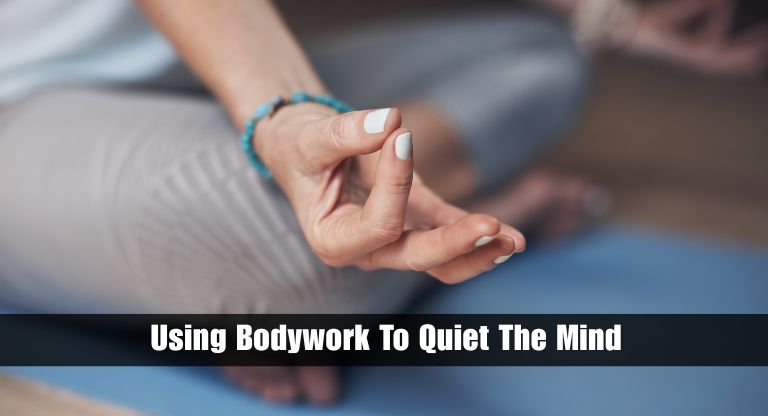Using Bodywork To Quiet The Mind

With all the activity of today’s world, our minds never stop. Between emails and deadlines, social media and pressures of everyday life, it’s clear that we can’t chill. We need to seek peace by attempting to “think ourselves” into calmness through meditation apps, to-do lists, and productivity tips. What if, though, the secret to a still mind is not in the mind?
Bodywork: your gentle reset button
Bodywork is a treatment modality that focuses on the mind-body connection. Bodywork is primarily made up of massage, stretching, breathing, somatic techniques, as well as other less moving practices such as yoga. Bodywork is mostly about physical comfort, but bodywork is also incredibly powerful and helps our mental discomfort as well.
Let us take a look now at how and why.
The Mind-Body Connection
You’re probably aware of the concept of the “mind-body connection,” and while this sounds cooler than a lot of spa, it is not something I am about to propose is hypothetical! Our thoughts, the way we feel, and our experiences are constantly connected to our physical bodies. Think about how your body reacts or feels during an anxious moment, likely your shoulders, and it happens in reverse as well. When your body gets tight, your mind tends to follow suit. The good thing is that releasing the physical tension in bodywork has a direct effect on your mind. It’s as if sending a message to your brain that “we are safe, you can relax now.”

Why Bodywork Works?
The following are several reasons why bodywork is so good at calming the mind:
1. It shifts your focus
Bodywork draws your focus away from thinking and into the here and now. Whether it is the sensation of a therapist’s hands coiling out kinks in your shoulders or the intense stretch of a yoga pose, bodywork tenderly draws you out of your head and into your body.
2. It releases stored tension
Our bodies carry emotions, mainly stress and trauma, within muscles, ligaments, and connective tissue. Bodywork methods effectively release that tension, which can feel like you have released a burden you never knew you were carrying. This most often brings the association of relaxation.
3. It engages the Parasympathetic nervous system
When you are relaxed, you usually shift systems to your parasympathetic nervous system, the “rest” and “digest” state, opposite our “fight or flight” system that we are usually stuck in. Bodywork can help to start this relaxation response, helping your heart rate to decrease, your blood pressure to drop, and your mind to rest.
4. It encourages deep breathing
Several bodywork therapies help to naturally make slower, deeper breaths. Deep breathing restores brain oxygen flow and calms anxiety. Breathing deeply is the only way of saying to your nervous system, “It’s all right. We can take it easy.”

Types of bodywork that calm the mind
There’s no one-size-fits-all formula, so it’s worth investigating various types of bodywork to discover what works for you. Here are a few favorites:
Massage therapy
Timeless and effective, massage relaxes tension in the muscles and allows for relaxation. A Swedish or a more focused deep tissue massage, massage offers a safe haven in which to release body and mind.
Myofascial release
This method targets the release of the fascia, the connective tissue that covers muscles. It can address chronic tension and has a very calming effect. Individuals frequently report feeling lighter emotionally after a treatment.
Somatic therapy
Somatic therapy combines talk therapy and an awareness of the body to help you notice the physical sensations attached to emotional experiences. Once you notice where stress is located in your body, you can start to let it go.
Yoga and breathwork
While not technically “bodywork” in the traditional sense, breathwork and yoga are very effective approaches for calming the mind. Gentle yoga exercises (such as breathing and stretching) can alleviate anxiety and foster calmness.
Craniosacral therapy
Using soft, gentle hands-on therapy takes a hands-on approach to working with the craniosacral system, brain, and spinal cord. It’s quiet, almost undetectable, but effective, and people tend to leave feeling really relaxed, if not almost meditative.

Aiming bodywork into your daily habits
You don’t have to schedule a 90-minute massage once a week (though if you can, do it!). Even minor, frequent doses of bodywork can have a dramatic impact.
These are some simple ways to integrate it into your daily life:
- Take daily 5-minute stretch breaks.
- Get a monthly massage as part of self-care.
- Practice a body scan meditation to become aware of your physical feelings.
- Perform simple self-massage with a massage ball or foam roller.
- Practice deep breathing exercises first in the morning or at night.
- Take a gentle yoga class, online or in person.
Final thoughts
In a world that continually demands more concentration, more productivity, more thinking, it’s simple to overlook the fact that we already possess the means to quiet ourselves, and sometimes the simplest way to stifle the mind is not to think more or do more, but simply to return to the body. Bodywork offers a gentle invitation to slow down and return to our bodies to normal. When the body is safe, grounded, and loved, the mind usually follows. The next time your mind is going a mile a minute, and you can feel the weight of anxiety sneaking in, just stretch, breathe, or plan that massage! Your mind will thank you.







